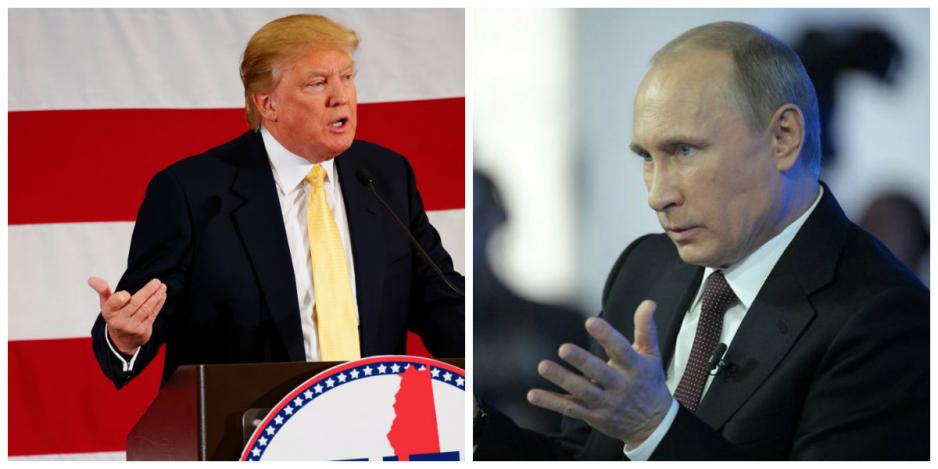Op-ed: Trump in the High North?

The United States Looks North: When President Obama lifted the High North on the Washington agenda, his gaze was on climate change, the Paris Agreement and the protection of Alaska's marine and rural areas. Obama's "reset" button with Russia and the US pivot towards China involved cooperation with these countries in the Arctic, writes Andreas Østhagen. (Photo of Trump: Michael Vadon).
The Pentagon points to both China and Russia as possible threats in a "strategic race" in the Arctic. What does this mean for Norway?
This is an opinion piece written by external contributors. All views expressed are the writer's own.
Ice is melting in the Arctic. Russia invests in military bases and oil fields. China knocks on the door and claims they are a "near-Arctic state". Norway has since 2006 argued that the High North is our most important strategic area of focus. Now, Trump has also opened his eyes to the Arctic, which might entail that Norway ends up in a pinch.
The United States Looks North: When President Obama lifted the High North on the Washington agenda, his gaze was on climate change, the Paris Agreement and the protection of Alaska's marine and rural areas. Obama's "reset" button with Russia and the US pivot towards China also involved cooperation with these countries in the Arctic.
Trump, on the other hand, has other thoughts. Two and a half years into Trump's presidency, the White House has still not formulated a concrete policy for the Arctic. But with statements by Foreign Minister Pompeo in Finland last month, and the US Department of Defense's new Arctic strategy launched Friday, some signs have become apparent.
First, focus is on China. So far, China plays a minimal role in the Arctic compared to the Arctic countries with access to the Arctic Ocean; Russia, Canada, Norway, USA and Denmark (Greenland). Nevertheless, both the US Secretary of State and the Pentagon choose to highlight China's economic and strategic (read military) ambitions in the region as a growing problem for the United States. This is not just about China's role in the north, it's about the Trump administration's desire to challenge China's emergence to as many arenas as possible.
Russia is then described as a threat to stability and cooperation in the north. This is nothing new on its own, as the rhetoric concerning Russia coming from the White House changed with Russia's annexation of the Crimea in 2014. At the same time, deliberately doing it in an Arctic context is a shift. Where Obama and his advisers wanted to compartmentalise the northern areas from conflict with Russia, Trump highlights and points to challenges with Russia in the north.
At home in Alaska, the tone has also changed. Environmental concerns and restrictions have been removed. Alaska is in a deep economic crisis, due to a fall in oil production and poor economic governance at a State level. The solution is now thought to lie in the disputed opening of a vast animal reserve – the Arctic National Wildlife Refuge - where oil is expected to be readily available.
A delicate balance: These trends lead to challenges for Norway. Norway is exposed as it shares a maritime boundary and land border with Russia. That country is increasingly testing Norway’s ability to respond to and monitor military activity in the Barents region. China's appearance in the north - despite uncertainty about the country's intentions - can also challenge Norway's interests. This applies, for example, to the agreement on fishing in the Arctic Ocean, Norway's policy on Svalbard, and the preservation of the Arctic Council as the region's foremost cooperative body.
At the same time, Norway is totally dependent on a constructive relationship with its nearest neighbor in the east, characterized by a low levels of tension and cooperation across the border at Storskog. In addition, both Norwegian businesses and the current Government want an improved relationship with China, after being kept at an arm’s length for almost a decade with the award of the Nobel Peace Prize to Liu Xiaobo in 2010. China is a growing superpower that will increasingly intervene in and influence policy areas that concern Norwegians. Norway cannot avoid Chinese interests, although on some issue these might be contradictory to Norwegian interests.
Norway in a pinch: The US is Norway’s most important security ally. In its new Arctic strategy, the Pentagon emphasizes cooperation with precisely Norway in the High North. NATO exercises such as Cold Response and the comprehensive Trident Juncture in 2018 are mentioned as important counterreactions to Russian activity in the Arctic. Joint operations with Norway in the North Atlantic are also deemed central. Here lies Norway's strongest card: its role as a guardian and at the same time bridge builder (with Russia) in the High North.
When the United States describes the situation in the High North as a black and white scenario - in line with Trump's general foreign policy rhetoric - Norway ends up in a pinch. The nuances of the situation in the north are more important for a small country like Norway that shares a border with Russia, than for the United States under Trump's "America first"-policy. Norway must thus work hard to ensure that decision-makers in Washington DC understand the country’s vulnerable position.
Norway can be pleased that Trump seems to get along with Jens Stoltenberg. Trump was central for the decision to extend Stoltenberg's period as NATO's Secretary General until 2022. The political game between the United States, Russia and China in the Arctic will continue in the years to come, and Norway is placed in the middle of it.

